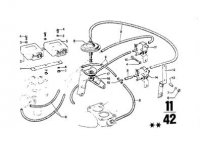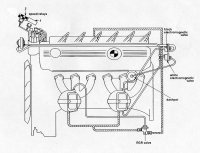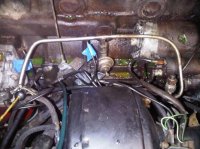Here's what I have found after yanking off the carbs and manifolds last night:
1. Whoever wrote the tech manuals either has never actually worked on the cars or is a sadist or both, the simple wording "remove the four nuts to the carburetor base" actually means spend all evening finding four different combinations of wrenches/ratchets to access the nuts, contort yourself in unimaginable ways, get smeared in 38 year old grime, and curse like a sailor.
2. Anyway, I have the stainless steel piping EGR setup (see pic), the vacuum nipple on it was not hooked up to anything, should this go to the passenger side carburetor vacuum connection which had been capped by someone? If not then where does this hook up to? Do these go bad? My air cleaner only has 2 nipples for vacuum tubes, nothing else there. One tube off the 4-piece vacuum tube connector goes under the front fender to a charcoal cannister or something under there, 2 go to the air cleaner, and one goes to the carb.
3. In removing the carbs and intake manifolds I noticed a few of the nuts were loose, likely the result of time and contributing to air leaks. I ordered new manifold gaskets, large rebuild kits, and the thin coolant hose from Mesa this am (Spence is very helpful and knowledgeable-is he on here?). I am going to clean and rebuild everything fuel related, and make sure all is tightened up, and replace all the coolant hoses down there while into this because they are accessable now, I cant imagine the PITA of getting to them with the manifolds on, especially that little 5" hose that connects to the block in the back off the rear choke housing.
4. To take full advantage of the slippery slope I am on, I am considering replacing the starter, for the same PITA reason as stated in #3.
What I would find helpful at this point is any advice on rebuilding the carbs and the proper connection of the egr valve and emissions/vacuum system. I've got the distributor piping figured out. I also have a wire needing identification under a separate post here.
Thanks for everyone's help on this board, it's much appreciated and minimizes the uncertainty when undertaking this and keeping the old girl running.
It would be very high odds that both carbs are leaking; possible, but not probable. Go back over everything you can tighten, or has vacumn. I know you have a low mileage coupe, but from you've posted don't understand what emissions devices you have now that can effect the carbs. ( EGR with ss piping?, solenoid valves for advance and retard?, fuel return?, Air cleaner warm up controls?) The EGR, if malfuctioning open it would definately effect both carbs and lean them out.( Leak)
If you're chasing things down you have to get and stay in idle RPM. First linkages ( clean and greased), then adjustments. By each carb and then together.
Since you're dealing with fixed jets, everything else is small adjustments. It is absolutely critical that the air/ throttle plate screws first get you in the ballpark with best running/ highest vacumn, not the idle mixture screws. They are used for small adjustment. If the small adjustment isn't working, it's usually because the basic fuel/ air mixture is off or the circuit is plugged. ( Throttle plates opened from normal or fuel level is off or dirt.)
When chasing down air leaks, you almost have to be surgical with the carb cleaner as it tends to go everywhere including back down the carb throat. Suspected leaks around the throttle shaft can also be base gasket,plate gasket, choke cover gasket(s), secondary vacumn can attachment gasket or diaphram.
Leaks around the cold start box are usually from the wrong gasket sequence and not loosening the bottom bracket so the banjo bolt is snug.
Walker kits are known to have incorrect gaskets for the venturi's ( wrong size), cold start box ( wrong thickness), and mis indexed choke diaphram; so be on the look out for this.
Hope this helps.. keep the cards and letters coming.









